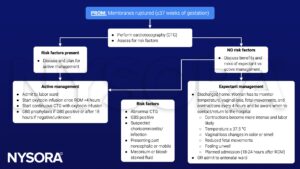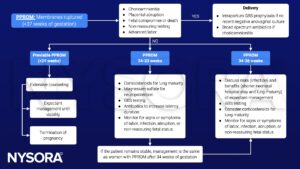Learning objectives
- Define prelabor rupture of membranes
- Understand the complications of prelabor rupture of membranes
- Management of prelabor rupture of membranes
Definition and mechanisms
- Prelabor rupture of membranes (PROM), previously known as premature rupture of membranes, is the breakage of the amniotic sac before the onset of labor
- It may occur at term (≥37+0 weeks of gestation) or preterm (<37+0 weeks of gestation), the latter is preterm PROM (PPROM)
- Occurs in approximately 8% of term pregnancies and 30% of preterm pregnancies
- 50% of patients will deliver within one week
Classification
- PROM: Rupture happens early, at least one hour before labor has started
- Prolonged PROM: More than 18 hours have passed between the rupture and the onset of labor
- Preterm PROM (PPROM): Rupture occurs before 37 weeks of gestation
- Midtrimester PPROM or previable PPROM (<1%): Rupture occurs before 24 weeks of gestation, the fetus cannot survive outside of the mother’s uterus before this age
Signs and symptoms
- Painless gush or steady leakage of fluid from the vagina
- Loss of fluid may be associated with the baby becoming easier to feel through the belly, decreased uterine size, or meconium seen in the fluid
Complications
Maternal
- Placental abruption
- Infection (e.g., chorioamnionitis)
- Postpartum endometritis
- Future PROM in later pregnancy
Fetal
- Premature birth and related complications (e.g., bronchopulmonary dysplasia, necrotizing enterocolitis, intraventricular hemorrhage, cerebral palsy)
- Umbilical cord compression or umbilical cord prolapse
- Infection (e.g., sepsis)
- Abnormal fetal presentation (e.g., breech presentation)
Risk factors
- Infection: Infection of the amniotic fluid (chorioamnionitis), urinary tract infections, sexually transmitted diseases, lower genital tract infections (e.g., bacterial vaginosis)
- Prior PROM or preterm delivery in previous pregnancies
- Polyhydramnios
- Multiple gestation
- Vaginal bleeding
- Maternal smoking
- Maternal drug use
- Mother who is underweight, nutritional deficits
- Invasive procedures (e.g., amniocentesis)
- Cervical insufficiency (i.e., short or prematurely dilated cervix during pregnancy)
Treatment
Treatment depends on the gestational age of the pregnancy, health status of the fetus, and whether complications are present
- Delivery: Fetal compromise, infection, or evidence of fetal lung maturity or gestational age ≥34 weeks
- Expectant management: Treatment to delay labor including precautions like bed rest, medications (i.e., antibiotics, corticosteroids, and magnesium sulfate), and frequent monitoring for infection or fetal distress
Management


Prevention
- Any woman with a history of preterm delivery (with or without PROM) is recommended to take progesterone supplementation to prevent a recurrence
Suggested reading
- Dayal S, Hong PL. Premature Rupture Of Membranes. [Updated 2022 Jul 18]. In: StatPearls [Internet]. Treasure Island (FL): StatPearls Publishing; 2022 Jan. Available from: https://www.ncbi.nlm.nih.gov/books/NBK532888/
We would love to hear from you. If you should detect any errors, email us customerservice@nysora.com







